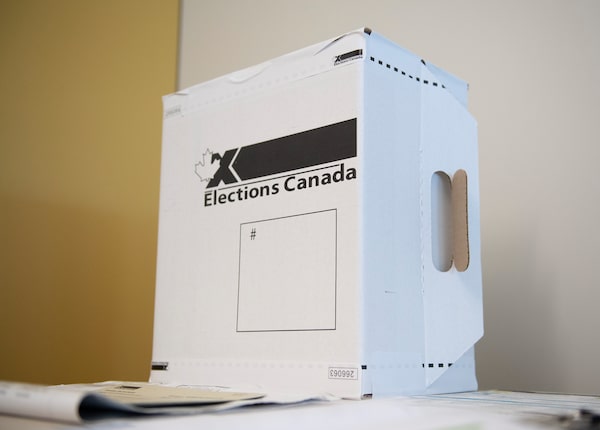
Voting by mail has been available since 1993 and has been used by a small percentage of the electorate over the years, but an estimated two to three million voters expected to stay home and mail in their ballots due to the pandemic.Justin Tang/The Canadian Press
Several million Canadians are expected to cast ballots by mail for the first time during this federal election, a pandemic-era shift that’s prompting the major political parties to change the way they’re reaching voters and altering the timing of their campaigns.
Voting by mail has been available since 1993, but until now has only been used by a tiny percentage of the electorate. The pandemic has changed that, with an estimated two to three million voters expected to stay home and mail in their ballots, according to Elections Canada – up from around 55,000 in the last federal election.
Some parties’ war rooms have chosen to release platforms sooner to reach people who may be casting their vote weeks in advance of election day. The NDP released their platform on Aug. 12, before the election was even called, and the Conservatives dropped theirs on day two of the campaign.
Bloc’s strength could determine who forms the next government
O’Toole says Conservatives who took part in anti-Trudeau protests aren’t welcome in his campaign
The Liberals and Green Party, meanwhile, still haven’t revealed their full platforms, and some observers say they may risk losing voters who are making their decisions before key campaign milestones, such as the leaders’ debate on Sept. 9. In most cases, however, it’s believed to be party loyalists, not undecided voters, who are voting early.
The upside to the increase in mail-in ballots for all parties is that they have more time to mobilize their supporters, and it puts less emphasis on a last-minute push to get voters to the polls.
“They’ve now got a much longer period to get people to actually vote. Instead of trying to get out the vote over an intensive one-day period, you’ve got two weeks or more,” said Ken Boessenkool, a former Conservative party strategist and speech writer for Stephen Harper.
“There’s a huge advantage there, and parties have the infrastructure in place to do this. And the sooner you can get the core voters out of the way, the sooner you can focus on the undecided and identify those voters.”
Canada’s political parties have been getting better at targeting advance voters in recent years, thanks in large part to platforms such as Facebook that allow them to more easily identify and contact supporters, Mr. Boessenkool said. An increase in mail-in ballots also allows parties to better concentrate money and energy where it’s needed most – in swing ridings where the election is up for grabs, he added.
While an unprecedented surge in mail-in ballots is new territory, it can also be a good thing for democracy, and help campaigns potentially find new voters who in the past have avoided polling stations.
“There are a lot of voters who still find it hard to access elections, even outside of the pandemic,” said Amanda Bittner, a professor of political science at Memorial University in St. John’s. “There are a lot of reasons to think mail-in ballots can boost voter turnout in general.”
Elections Canada said it has closely studied the five most recent provincial elections, which all saw spikes in mail-in, or special-ballot, voting because of the pandemic. For the federal election, it plans to hire more than 250,000 staff, bought more than 18 million face masks for in-person voting and is reassuring voters its mail-in ballot verification system is secure.
The federal election agency doesn’t have to look far for examples of what can go wrong in a pandemic election. The March election in Newfoundland and Labrador was upended by mass confusion around mail-in ballots after a COVID-19 outbreak cancelled all in-person voting. In some remote communities in Labrador, challenges around getting voter kits to and from some residents plunged the voter turnout to less than 25 per cent.
“I think everyone involved in elections in this country watched what happened in Newfoundland and Labrador with horror,” Dr. Bittner said. “It looks like Elections Canada saw that and has planned for that, and will give voters more time to get their votes in. The positive thing is that they’ve set up a system from the get-go that is clear.”
Early estimates were as high as four to five million voters would want to cast ballots through the mail, but that number has been reduced as vaccination rates improve. As of Aug. 25, 145,885 Canadians had been issued mail-in voting kits through online applications that take up to three days to process.
Voting officials are already warning Canadians to expect delays in election results after polls close on Sept. 20, and are telling voters in far-flung corners of the country to factor in extra time for the mail system to return their completed ballots. In some ridings, it may be days before final results are known.
“These delays will be necessary and normal,” said Françoise Enguehard, a spokesperson for Elections Canada. “We’re in uncharted territory. But we want to make sure every vote is counted, and counted correctly.”
In the British Columbia election in October, 2020, more than 31 per cent of votes came through the mail – a significant jump from the fewer than one per cent of B.C. voters who used that option in 2017.
Similar patterns were seen in Saskatchewan, New Brunswick, Newfoundland and Labrador, and Nova Scotia provincial elections. Except for Nova Scotia, where the incumbent Liberal government was defeated earlier this month, voter turnout dropped in every pandemic campaign.
Some voters said they’ll be voting by mail for the first time because they’re not comfortable walking into a crowded polling station during COVID-19′s fourth wave.
Calgary’s Daorcey Le Bray said he and his wife have taken their six-year-old daughter to vote with them since she was an infant, and said it’s important to them to teach her about the election process. This time around, however, they felt it was best to cast their votes from home.
“COVID makes us nervous, and although we’re fully vaccinated, our daughter isn’t. I wouldn’t have been comfortable bringing her inside, waiting in line, and going into a voting booth with her,” he said. “Voting by mail felt like the best way to include her in the process. For us, it was an easy decision.”
Mail-in ballots will be counted in two ways. International or national votes, which are votes cast for ridings outside of the communities voters live in, will be processed at a central facility in Ottawa where counting can begin up to 14 days prior to the end of the election. Many of those votes will come from university students, military members or Canadians living abroad.
Local votes, mailed by people voting for candidates in their local riding, will be counted at their local election office. Those ballots won’t be opened until after polls close, and will be checked against the voters’ registry to ensure people aren’t voting twice. It’s these ballots that are most expected to delay results.
Local ballots sent from inside a voter’s riding must be received by the time polls close in that riding. Ballots sent from outside a voter’s riding, or national votes, must be received by 6 p.m. Eastern Time on election day.
That means people in remote communities will need to mail their ballots earlier than someone who lives in Toronto in order for it to arrive on time, Ms. Enguehard said. While this may be new territory for a lot of Canadians, she wants voters to feel like they can trust the system Elections Canada has in place.
“Mail-in ballots are not a new thing. It’s been around, and it’s been proven to work,” said Ms. Enguehard, who is encouraging voters to apply for their mail-in kits as early as possible. That can be done online at elections.ca or in-person at local election offices.
“The only unknown this time around is the amount of people who will avail themselves of that option. We are ready for a lot of people to do it.”
Our Morning Update and Evening Update newsletters are written by Globe editors, giving you a concise summary of the day’s most important headlines. Sign up today.
 Greg Mercer
Greg Mercer Chen Wang
Chen Wang